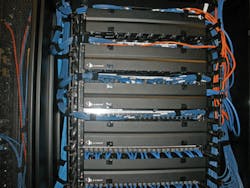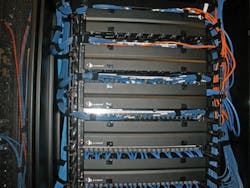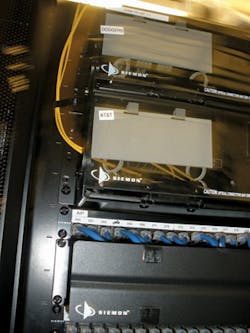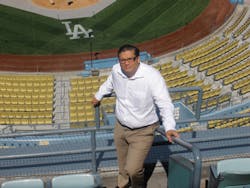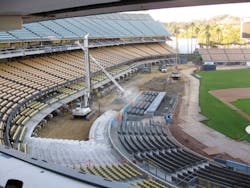From the September, 2014 Issue of Cabling Installation & Maintenance Magazine
Two offseasons of overhauling Dodger Stadium included the installation of fiber-optic and copper cabling to support numerous technology upgrades.
By Robert Carlson, Siemon
While the rest of us were watching football, hockey and basketball, something big was happening at Dodger Stadium. The 52-year-old home of the Los Angeles Dodgers and third-oldest park in Major League Baseball spent the past two offseasons undergoing more than $150 million of stadium upgrades.
Many of the enhancements were obvious to fans on opening day of the Dodgers' 2014 season in early April, including expanded entries, new seating and lounges, additional food services, new retail stores, memorabilia displays, improved access, beautified landscaping and a fenced walkway for navigating the stadium's entire circumference.
Plenty of new technology was also a key component of the upgrade and one that was carefully considered to enhance the experience of longtime fans. Not only will fans have access to state-of-the-art wireless throughout the stadium, but season and mini-plan ticket holders will enjoy the new Dodgers Pride Rewards program that allows them to use their smartphones to gain entrance at all gates, make purchases, order food and beverages, and check earned rewards. In turn, the program will allow the stadium to keep tabs on fan preferences and provide a more-tailored game experience. Enhanced technology will be improving performance of the players on the field by supporting data analytics and video replays from the past eight years of plays.
What won't be obvious to the fans and players is Siemon's high-performance copper and optical-fiber cable systems installed throughout the stadium that make all of this exciting technology possible.
Forming a dedicated team
One of the first upgrades at Dodger Stadium that was a critical foundation for all other enhancements was the electrical service. "We had electrical systems in place that were 40 and 20 years old, and these systems typically have a life expectancy of 15 to 20 years," said Ralph Esquibel, the Dodgers' vice president of IT. "Those systems were at the end of their life and we couldn't do much of anything innovative like implement larger video boards or other technologies that needed more power."
During the first phase of the expansion during the 2013 offseason, the stadium deployed new equipment and substations in coordination with the Los Angeles Department of Water and Power. With an updated electrical infrastructure in place, the Dodgers' IT department was able to turn their focus to the network cabling infrastructure.
During the design stages of the network, Esquibel encountered Siemon's products and expertise during his research. After reaching out to Siemon for more information, a new dedicated team was formed.
"When I started meeting the people at Siemon, I realized that they were smart people who knew what they were talking about," Esquibel said. "Valerie Maguire, Siemon's director of standards and technology, came and met with us several times and made quite an impression on me. Since the beginning, Siemon has been invested in the L.A. Dodgers and our success. While we may have a big name, we are actually a small company with only about 300 employees. That's why I look for true partnerships in my vendors and require that they act almost as extensions of my team. We looked at other companies, but it was Siemon that gave us that level of comfort."
Ed Havlik, Siemon's sales manager for the project, assembled a team of technical and product resources who were ready to lend expert support when needed. For example, when discussions arose related to the pros and cons of various wireless technologies, Havlik made sure that Esquibel and Maguire connected.
"It was clear from our first meeting that Ralph had a vision of providing guests at Dodger Stadium with the highest level of electronic technology," said Maguire. "Ralph wanted to hear our thoughts on the entire gamut of IT technologies-from which products would best support fans at outside kiosks and entry points, to ensuring congestion-free support of IEEE 802.11ac wireless and which media would be most mechanically and electrically suited to support Type 2 PoE. He even sought our recommendation on how to best save space in the data center."
Building a reliable backbone
Once the decision was made to deploy Siemon cabling systems for the upgrade, the project went out for bid. Due to the sheer size of the installation, several entities were involved in the installation, which included upgraded core switches in two main equipment rooms, new telecommunications rooms (TRs), and faster transmission speed via plenty of Siemon fiber and copper cabling.
"With all of the technology we wanted to add, we knew we had to introduce a 10-Gigabit-per-second edge network and deploy new core switches, firewalls and redundancy," said Esquibel. "In 1963 when the Dodgers first started playing here there were no telecommunications rooms. As part of the upgrade, we built out 18 proper rooms that tie back to the two updated cores via 24 strands of singlemode optical fiber."
According to Esquibel, the L.A. Dodgers also have a redundant data center at their spring training center in Arizona that is capable of running 90 percent of the stadium business in the event of downtime-which is something Esquibel doesn't foresee. "We have the redundancy and reliability in place that I don't foresee our network ever going down completely and having to rely on backup from Arizona," he said.
In each of the main equipment rooms, switches and networking equipment are housed in Siemon's VersaPOD cabinets that feature zero-U cable management and vertical patching capabilities to support high density while saving space and providing excellent thermal efficiency through improved airflow in and around the equipment. Within the VersaPOD cabinets, Siemon's intelligent power distribution units (PDUs) provide even more energy savings while reliably delivering power to the critical IT equipment. The PDUs can provide real-time power information and connect to environmental sensors for troubleshooting and optimizing energy efficiency.
Within the main equipment rooms and TRs, the singlemode fiber is terminated at Siemon's Quick-Pack adapter plates and housed in RIC3 enclosures that provide superior protection of the fiber and enhanced accessibility with front and rear door locks, and a fully removable fiber-management tray. Depending on size and configuration, a combination of Siemon's VersaPOD cabinets, V600 cabinets and four-post racks were deployed in the TRs to support active equipment and passive connectivity.
Meeting expectations
From each of the TRs, Siemon's Z-Max Category 6A shielded (F/UTP) end-to-end cabling system supports a wide range of devices throughout the stadium to bring technology to the fans and the field. The Category 6A F/UTP cable is terminated on Z-Max patch panels in each of the TRs and at Z-Max 6A outlets for voice and data access in offices, wireless access points (WAPs) throughout the stadium, point-of-sale locations, box offices, kiosks, scanners and at several locations for eventually connecting digital displays, IPTVs and IP-based surveillance cameras.
While Dodger Stadium hasn't yet switched over video displays and cameras to IP-based systems using the Siemon cabling, Esquibel knew it made sense to install cabling to all of these locations while the walls were open. The stadium was, however, able to roll out digital scanning locations for the Dodger Pride Rewards program and the largest WiFi network ever in Major League Baseball.
"Wireless is now like a utility," says Esquibel. "People show up at a venue to enjoy themselves and expect WiFi access in the same way they expect to be able to turn on the water in a bathroom. We have successfully architectured our WiFi infrastructure to support 50% of our 56,000 fans at any given moment."
Unlike traditional overhead placement of WAPs, Dodger Stadium used a heterogeneous approach and placed the approximately 1,000 WAPs in unique locations that provide much better coverage. "If you only place the access points overhead, people in the prime front-row seating end up with poor service," explains Esquibel. "To provide the best coverage, we're using a combination of overhead and underseat placement. We even have some access points placed within hand rails."
Protecting the investment
Siemon's Z-Max 6A shielded solution that supports all the WAPs and other technology throughout the stadium represents the cutting edge of Category 6A cabling. The Z-Max 6A shielded system provides the highest margins on all TIA and ISO performance requirements for Category 6A/Class EA, including critical alien crosstalk parameters.
"This has been a huge undertaking, and I don't know when we'll be able to make this type of investment again," says Esquibel. "We decided to go with shielded cabling to protect the harmonics of the cable and provide better performance for future technologies. For example, when next-generation 802.11ac wireless devices hit the market we can easily swap out access points because we have the cabling in place to support the bandwidth and Power over Ethernet requirements."
To further protect the technology investment, Dodger Stadium deployed Siemon's industrial networking solutions in harsher areas, such as concession stands and kiosks. At these locations, Siemon ruggedized/industrial Max IP67-rated outlets and modular cords offer total protection against dust ingress and short-term protection against water ingress, as well as the ability to withstand higher temperature and humidity ranges. The ruggedized/industrial Max outlets feature a durable, chemical-resistant, industrial-grade thermoplastic and patented bayonet-style quarter-turn mating design for superior protection.
Due to the stringent timeline and the need to finalize the cabling infrastructure in time for opening day of the 2014 season, superior logistics and just-in-time delivery were also vital to the project's success. Siemon partnered with Accu-Tech Los Angeles to ensure proper warehousing and staging of the cabling components in conjunction with the installation schedule.
"This was a huge project with many reels of cable. We had to work behind the scenes to make sure we could consistently stage and release product as it was needed," says John Ittu, branch manager for Accu-Tech Los Angeles. "Our dedicated driver was familiar with the stadium and knew where and when to deliver the material. It was a great experience and exciting for us to be a part of something like this, and actually go into the stadium and see where all of the cabling we supplied was being installed."
Winning on and off the field
After their 92-win campaign and trip to the NLCS in 2013, the Los Angeles Dodgers embarked on their 2014 season with their upgraded stadium and high-performance cabling infrastructure that will satisfy fans' demands, and hopefully improve their on-field performance.
Esquibel says, "We're not done implementing technology, but we'll get there because we have a great IT team that is dedicated to this baseball team and the organization. Throughout this technology upgrade, we've always asked ourselves how we are going to give our fans a better experience. The ability for our fans to interact with the team through the Dodger Pride Rewards program is the direction that any consumer-facing industry should be moving in. Not only will we be able to tailor their game experience with exclusive offers, but fans appreciate the convenience of being able to order food right from their smartphones and avoid lines."
He concludes that the technology upgrade will also deliver a better game and help better prepare the players. "We have eight years of video on every player and every play that has transpired here. With our new cabling infrastructure, the players will have the ability to quickly and easily access the videos we need-they won't accept lag time."
Robert Carlson is vice president of global marketing for Siemon (www.siemon.com).
